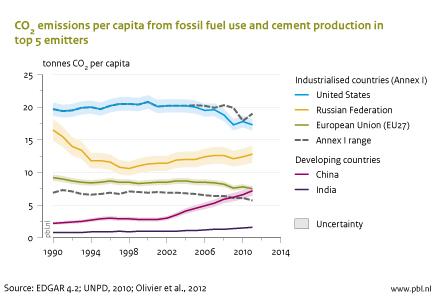Per capita CO2 emissions in China reached European level
Global emissions of carbon dioxide (CO2) increased by 3% last year, reaching an all-time high of 34 billion tonnes in 2011. In China, average per capita CO2 emissions increased by 9% to 7.2 tonnes CO2. This is similar to per capita emissions in the European Union.
Global CO2 emissions continue to increase
In comparison, in 2011, the United States was still one of the largest emitters of CO2, with 17.3 tonnes in per capita emissions. These emissions are decreasing in many OECD countries, as a result of both the recession and high oil prices, while China’s emission levels have been expanding rapidly, due to its economic growth rate and especially the high level of construction activity. CO2 emissions in all OECD countries now equal those in China and India combined: each representing one third of global emissions.
These are some of the main findings of the annual report ‘Trends in global CO2 emissions’, released today by PBL Netherlands Environmental Assessment Agency and the European Commission’s Joint Research Centre (JRC).

Top 5 emitters: US and EU emissions decrease, those in China, India and Russia increase
Using recent results from the Emission Database for Global Atmospheric Research (EDGAR) and latest statistics on energy use and other activities, the report shows that global CO2 emissions from fossil fuel combustion and other sources, such as gas flaring and cement production, increased by 3% in 2011.With a decrease in 2008 and a 5% surge in 2010, the past decade saw an average annual increase of 2.7%. The top 5 emitters are China (share 29%), the United States (16%), the European Union (EU27) (11%), India (6%) and the Russian Federation (5%), followed by Japan (4%). The fact that global emissions continued this historical growth trend in 2011 seems remarkable at first sight, considering that in many OECD countries CO2 emissions in fact decreased – in the European Union by 3%, in the United States by 2% and in Japan by 2% – mainly due to weak economic conditions in many countries, mild winter weather in several countries and high oil prices. More important, however, is that CO2 emissions from OECD countries now account for only one third of global emissions – the same share as that of China and India, where emissions increased by 9% and 6%, respectively, in 2011.
The increase in China’s CO2 emissions was mainly due to a continued high economic growth rate, with related increases in fossil fuel consumption. This increase in fuel consumption in 2011 was mainly driven by the increase in building construction and expansion of infrastructure, as indicated by the growth in cement and steel production. Domestic coal consumption grew by 9.7% and coal import increased by 10%, making China the world’s largest coal importer, overtaking Japan.
Cumulative CO2 emissions could possibly surpass 2 °C global warming target
Since 2000, an estimated total of 420 billion tonnes CO2 was cumulatively emitted due to human activities (including deforestation). Scientific literature suggests that limiting average global temperature rise to 2 °C above pre-industrial levels– the target internationally adopted in UN climate negotiations – is possible if cumulative emissions in the 2000–2050 period do not exceed 1,000 to 1,500 billion tonnes CO2. If the current global increase in CO2 emissions continues, cumulative emissions will surpass this total within the next two decades.
Renewable energy supply expanding at accelerated speed
The share of ‘new’ renewable energy sources, such as solar and wind energy and biofuels, although still very small, is increasing with accelerated speed; it took 12 years, from 1992 to 2004, to double from a share of 0.5% to 1%, but only 6 more years to double again to 2.1% by 2011. This could potentially represent about 0.8 billion tonnes in avoided CO2 emissions in 2011 that would have been emitted from fossil-fuel power generation and road transport, which is similar to the current CO2 emissions in Germany. When including hydropower, the total share of renewables in energy supply is 8.5% or 1.7 billion tonnes potentially avoided CO2emissions.




